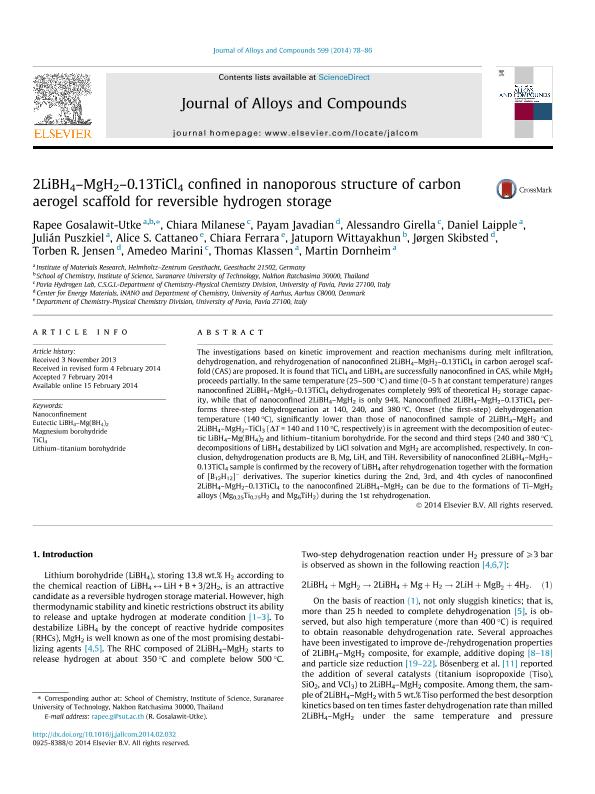Artículo
2LiBH4–MgH2–0.13TiCl4 confined in nanoporous structure of carbon aerogel scaffold for reversible hydrogen storage
Gosalawit Utke, Rapee; Milanese, Chiara; Javadian, Payam; Girella, Alessandro; Laipple, Daniel; Puszkiel, Julián Atilio ; Cattaneo, Alice S.; Ferrara, Chiara; Wittayakhun, Jatuporn; Skibsted, Jørgen; Jensen, Torben R.; Marini, Amedeo; Klassen, Thomas; Dornheim, Martin
; Cattaneo, Alice S.; Ferrara, Chiara; Wittayakhun, Jatuporn; Skibsted, Jørgen; Jensen, Torben R.; Marini, Amedeo; Klassen, Thomas; Dornheim, Martin
 ; Cattaneo, Alice S.; Ferrara, Chiara; Wittayakhun, Jatuporn; Skibsted, Jørgen; Jensen, Torben R.; Marini, Amedeo; Klassen, Thomas; Dornheim, Martin
; Cattaneo, Alice S.; Ferrara, Chiara; Wittayakhun, Jatuporn; Skibsted, Jørgen; Jensen, Torben R.; Marini, Amedeo; Klassen, Thomas; Dornheim, Martin
Fecha de publicación:
02/2014
Editorial:
Elsevier Science
Revista:
Journal of Alloys and Compounds
ISSN:
0925-8388
Idioma:
Inglés
Tipo de recurso:
Artículo publicado
Clasificación temática:
Resumen
The investigations based on kinetic improvement and reaction mechanisms during melt infiltration, dehydrogenation, and rehydrogenation of nanoconfined 2LiBH4-MgH2-0.13TiCl4 in carbon aerogel scaffold (CAS) are proposed. It is found that TiCl4 and LiBH4 are successfully nanoconfined in CAS, while MgH2 proceeds partially. In the same temperature (25-500ºC) and time (0?5 h at constant temperature) ranges nanoconfined 2LiBH4-MgH2-0.13TiCl4 dehydrogenates completely 99% of theoretical H2 storage capacity, while that of nanoconfined 2LiBH4?MgH2 is only 94%. Nanoconfined 2LiBH4-MgH2-0.13TiCl4 performs three-step dehydrogenation at 140, 240, and 380ºC. Onset (the first-step) dehydrogenation temperature (140ºC), significantly lower than those of nanoconfined sample of 2LiBH4-MgH2 and 2LiBH4-MgH2-TiCl3 (DT = 140 and 110ºC, respectively) is in agreement with the decomposition of eutectic LiBH4-Mg(BH4)2 and lithium?titanium borohydride. For the second and third steps (240 and 380ºC),<br />decompositions of LiBH4 destabilized by LiCl solvation and MgH2 are accomplished, respectively. In conclusion, dehydrogenation products are B, Mg, LiH, and TiH. Reversibility of nanoconfined 2LiBH4-MgH2-0.13TiCl4 sample is confirmed by the recovery of LiBH4 after rehydrogenation together with the formation of [B12H12] derivatives. The superior kinetics during the 2nd, 3rd, and 4th cycles of nanoconfined<br />2LiBH4-MgH2-0.13TiCl4 to the nanoconfined 2LiBH4-MgH2 can be due to the formations of Ti-MgH2 alloys (Mg0.25Ti0.75H2 and Mg6TiH2) during the 1st rehydrogenation.
Archivos asociados
Licencia
Identificadores
Colecciones
Articulos(CCT - PATAGONIA NORTE)
Articulos de CTRO.CIENTIFICO TECNOL.CONICET - PATAGONIA NORTE
Articulos de CTRO.CIENTIFICO TECNOL.CONICET - PATAGONIA NORTE
Citación
Gosalawit Utke, Rapee; Milanese, Chiara; Javadian, Payam; Girella, Alessandro; Laipple, Daniel; et al.; 2LiBH4–MgH2–0.13TiCl4 confined in nanoporous structure of carbon aerogel scaffold for reversible hydrogen storage; Elsevier Science; Journal of Alloys and Compounds; 599; 2-2014; 78-86
Compartir
Altmétricas



